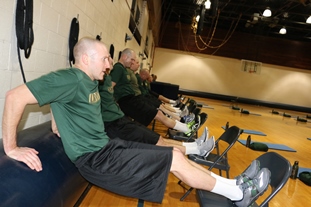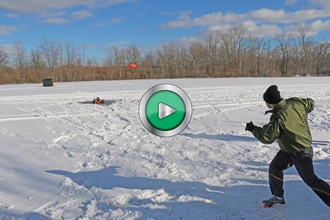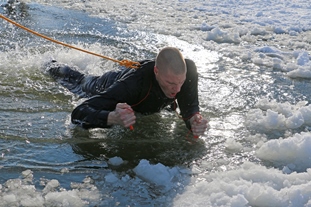Marching and ice rescues
Week 7: Feb. 14-20
The long Presidents’ Day holiday weekend gave the conservation officer recruits much deserved rest. They would need it, since 30 minutes after they arrived back at the academy Monday evening they suited up in physical training gear, including duty boots and backpacks containing 20-pound sandbags. The 75-minute march through the nearby Windsor State Game Area had begun. The 4-mile course included trails, woods, road and hills.
Searching remote areas for lost children, hunters and hikers is an important role performed by conservation officers throughout the state, and this exercise reinforced the importance of the physical endurance needed for long searches of missing persons over rough terrain.
At 6 a.m. the next day, it was time for more physical training, this time in “the tank,” the nickname given to the 12-foot-deep pool.
Auto theft
Following room inspection and breakfast, the 20 remaining recruits, one woman and 19 men, marched into the classroom Tuesday morning for instruction on auto theft, taught by Michigan State Police (MSP) Detective Sgt. Kyle McPhee. With training aides such as PowerPoints and videos, recruits learned about all aspects of various auto thefts, concentrating on snowmobiles and off-road vehicle (ORV) theft.
Criminal complaints
The remainder of the morning encompassed warrant request and court arraignment instruction with Conservation Officer (CO) Chris Holmes. Conservation officers often deal with these legal documents when they receive criminal complaints, including poaching. These complaints include the harvesting of deer prior to purchase of a hunting license.
 “It is illegal to harvest a deer prior to purchasing a kill tag, even if the animal is tagged after the purchase,” said Cpl. Todd Thorn, recruit school assistant commander. “When we receive a complaint that an individual has harvested a deer before purchasing a kill tag and then tagged it after the fact, we will investigate the complaint, write a report and seek charges against that individual.” “It is illegal to harvest a deer prior to purchasing a kill tag, even if the animal is tagged after the purchase,” said Cpl. Todd Thorn, recruit school assistant commander. “When we receive a complaint that an individual has harvested a deer before purchasing a kill tag and then tagged it after the fact, we will investigate the complaint, write a report and seek charges against that individual.”
Classroom instruction included information on testifying in court. In many cases, especially those involving poaching, conservation officers are subpoenaed to appear in court to testify.
After lunch, recruits headed to the gymnasium for more survival tactics training. They practiced handcuffing methods again, participating in a compliant citizen scenario.
Wednesday morning, recruits performed physical training in the gym, mainly working their upper body by doing pushups and pullups, in addition to short-distance running, dips and more.
Short-barrel shotgun
It was more legal training in the classroom that morning. Retired MSP Inspector David Greydanus taught contraband and regulatory crimes, spending time going page by page through the legal book. In addition, he brought in a short-barrel shotgun, an illegal firearm that was found and seized, now displayed as a teaching aide.
Jumping in
 After lunch, recruits shifted gears, leaving the warm compounds of the classroom for some chilly outdoor experiences on nearby Davis Pond. Here, recruits experienced what it’s like to fall through the ice and, more importantly, how to save their lives if they ever do. After lunch, recruits shifted gears, leaving the warm compounds of the classroom for some chilly outdoor experiences on nearby Davis Pond. Here, recruits experienced what it’s like to fall through the ice and, more importantly, how to save their lives if they ever do.
The ice had been thoroughly evaluated by conservation officers beforehand. However, since the Department of Natural Resources cautions the public that no ice is safe ice, extra measures were taken to ensure the safety of recruits and recruit school staff. With a warming trailer and tent nearby, a dive team on standby and while medically monitored, the recruits each took their turn jumping into a hole strategically cut in the ice. Read more about ice safety and why no ice is safe ice.
While clothed in their uniform, recruits learned how to get out of the water after falling through ice, including how to use their issued ice picks to pull themselves out and how, once free, to correctly roll away from the hole. Each recruit also had the opportunity to use a rescue disc to practice saving lives. Watch a short video about their experiences.
After warming in the trailer or tent and changing into dry clothes, each recruit participated in an ice-fishing scenario, learning how to properly check anglers.
 Afterward, the recruits ran in formation back to the academy, about a mile away. Afterward, the recruits ran in formation back to the academy, about a mile away.
No trespassing
Following Thursday morning PT, which included survival tactics training in the gymnasium, recruits reported back to the classroom for responding to crimes in progress training with Cpl. Michael Mshar.
Conservation officers often respond to trespassing complaints, and this was used as an example during instruction. Officers receive the complaint through the DNR communications dispatch center, contact the person issuing the complaint, attempt to locate the trespasser, verify if it is a crime and handle the situation.
Thursday afternoon included more survival tactics training, focusing on handcuffing and searching.
Public order crimes
It was more classroom instruction Friday, consisting of public order crimes, taught by Inspector Greydanus. This included crimes such as loitering and public indecency. Recruits spent time reviewing the elements of each law and the associated penalties.
Monitoring traffic
During the hour prior to lunch, recruits headed outdoors to the nearest intersection, participating in a traffic monitoring exercise aimed at learning to spot traffic violations. They recorded violations as they happened, including non-use of seat belts, failing to use a turn signal, speeding and more.
After exam review in the afternoon, recruits were dismissed for another weekend. They had now made it through a third of the academy!
Subscribe to the weekly conservation officer academy blog, which also is posted weekly on the Michigan DNR Facebook page. View past blogs from Recruit School No. 7.
/Photo details: Accompanying photos are available below for download. Caption information follows.
Ice rescue disc.jpg: Recruits learned to use a rescue disc to save individuals who have fallen through the ice. From a safe distance, a recruit throws the safety disc to another recruit who has jumped into the ice hole as part of an ice rescue training scenario.
Ice safety.jpg: During the ice rescue training exercise, recruits jumped into an ice hole in Davis Pond, located near the training facility, and learned to use their issued ice picks to maneuver out of the hole. Because no ice is safe ice, many precautions were taken to ensure the safety of all recruits and recruit school staff, including medical monitoring, the presence of a dive team, and a warming tent and trailer. In addition, recruits were secured to a safety rope when in the ice hole.
Abdominal crunches.jpg: Morning physical training alternates between running in formation outdoors, activities in “the tank,” a 12-foot-deep pool, and circuits in the gymnasium. Here, recruits do abdominal crunches during circuits./
The Michigan Department of Natural Resources is committed to the conservation, protection, management, use and enjoyment of the state’s natural and cultural resources for current and future generations. For more information, go to www.michigan.gov/dnr.
|

 “It is illegal to harvest a deer prior to purchasing a kill tag, even if the animal is tagged after the purchase,” said Cpl. Todd Thorn, recruit school assistant commander. “When we receive a complaint that an individual has harvested a deer before purchasing a kill tag and then tagged it after the fact, we will investigate the complaint, write a report and seek charges against that individual.”
“It is illegal to harvest a deer prior to purchasing a kill tag, even if the animal is tagged after the purchase,” said Cpl. Todd Thorn, recruit school assistant commander. “When we receive a complaint that an individual has harvested a deer before purchasing a kill tag and then tagged it after the fact, we will investigate the complaint, write a report and seek charges against that individual.”
 Afterward, the recruits ran in formation back to the academy, about a mile away.
Afterward, the recruits ran in formation back to the academy, about a mile away.




